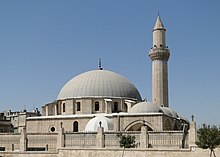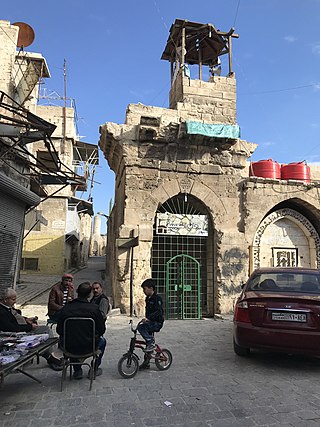Ummayads

- Great Mosque of Aleppo, 716 AD
Aleppo was never a capital of any of the grand Arab dynasties, but nevertheless the city's central position in the Levant between Damascus and Baghdad, and its closeness to Anatolia, helped the city to prosper fast. This is a list of mosques in Aleppo from different dynastic periods.









The Zengid or Zangid dynasty was an Atabegate of the Seljuk Empire created in 1127. It formed a Turkoman dynasty of Sunni Muslim faith, which ruled parts of the Levant and Upper Mesopotamia, and eventually seized control of Egypt in 1169. In 1174 the Zengid state extended from Tripoli to Hamadan and from Yemen to Sivas. Imad ad-Din Zengi was the first ruler of the dynasty.
The Burid dynasty was a Sunni Muslim dynasty of Oghuz Turkic origin which ruled over the Emirate of Damascus in the early 12th century, as subjects of the Seljuk Empire.

The Artuqid dynasty was established in 1102 as a Beylik (Principality) of the Seljuk Empire. It formed a Turkoman dynasty rooted in the Oghuz Döğer tribe, and followed the Sunni Muslim faith. It ruled in eastern Anatolia, Northern Syria and Northern Iraq in the eleventh through thirteenth centuries. The Artuqid dynasty took its name from its founder, Artuk Bey, who was of the Döger branch of the Oghuz Turks and ruled one of the Turkmen beyliks of the Seljuk Empire. Artuk's sons and descendants ruled the three branches in the region: Sökmen's descendants ruled the region around Hasankeyf between 1102 and 1231; Ilghazi's branch ruled from Mardin and Mayyafariqin between 1106 and 1186 and Aleppo from 1117–1128; and the Harput line starting in 1112 under the Sökmen branch, and was independent between 1185 and 1233.

Saif ad-Din Ghazi I was the Emir of Mosul from 1146 to 1149, who fought in the Second Crusade. He was the eldest son of Imad al-Din Zengi of Mosul, and the elder brother of Nur ad-Din.
Banū Tamīm is an Arab tribe that originated in Najd in the Arabian Peninsula. It is mainly present in Saudi Arabia, Qatar, Kuwait, Iraq, Jordan and Lebanon, a strong presence in Algeria, and Morocco, Palestine, Tunisia, and Libya. It is also present in many other parts of the Arab world such as Egypt and Khuzestan in Iran. The word Tamim in Arabic means strong and solid. It can also mean those who strive for perfection.
Hāshim ibn ʿAbd Manāf, born ʿAmr al-ʿUlā, was the great-grandfather of the Islamic prophet Muhammad and the progenitor of the ruling Banu Hashim clan of the Quraysh tribe in Mecca. At some point in his life before his father's death, 'Amr chose for himself the name Hāshim, as it was the name God used for Abraham. The narrations from Islamic hagiographists to explain this name change are varied: A narration suggests that `Amr was called Hashim because Hashim translates as pulverizer in Arabic. As a generous man, he initiated the practice of providing crumbled bread in broth that was later adapted for the pilgrims to the Ka'aba in Mecca. Another narration claims the name derives from the Arabic root Hashm, to save the starving, because he arranged for the feeding of the people of Mecca during a seasonal famine, and he thus came to be known as "the man who fed the starved".

Salamieh (Arabic: سلمية Salamieh) is a city and district in western Syria, in the Hama Governorate. It is located 33 kilometres southeast of Hama, 45 kilometres northeast of Homs. The city is nicknamed the "mother of Cairo" because it was the birthplace of the second Fatimid caliph al-Qa'im bi-Amr Allah, whose dynasty would eventually establish the city of Cairo, and the early headquarters of his father Abdullah al-Mahdi Billah who founded the Fatimid Caliphate. The city is an important center of the Shi'ite Nizari Isma'ili and Taiyabi Isma'ili Islamic schools and also the birthplace of poet Muhammad al-Maghut. The population of the city is 66,724.
The Banū Aws or simply Aws was one of the main Arab tribes of Medina. The other was Khazraj, and the two, constituted the Ansar after the Hijra.

The Arab Parliament is the legislative body of the Arab League. At the 19th Arab League Summit in Amman, the Arab states agreed to create an Arab Parliament, and came up with a resolution to give Amr Moussa the Secretary General of the Arab League the power to start and create the Parliament. In 2004, in the ordinary Arab League Summit in Algiers was the official date where all Arab League Members agreed to send their representative to the temporary Parliament sessions that took place in the headquarters of the Arab League in Cairo, Egypt, with each member state sending four members, until the Parliament is reassigned permanently to its under-construction office in Damascus.
The Ansar or Ansari are the local inhabitants of Medina who took the Islamic prophet Muhammad and his followers into their homes when they emigrated from Mecca during the hijra. They belonged to the tribes of Banu Khazraj and Banu Aus.

The Sheikh Zayed Grand Mosque is located in Abu Dhabi, the capital city of the United Arab Emirates. It is the country's largest mosque, and is the key place of worship for daily Islamic prayers. There is a smaller replica of this mosque in Surakarta, a city in Indonesia.
Islam is an Abrahamic monotheistic religion teaching that there is only one God (Allah) and that Muhammad is His last Messenger.

The Ancient City of Aleppo is the historic city centre of Aleppo, Syria. Prior to the Syrian Civil War, many districts of the ancient city remained essentially unchanged since they were initially constructed between the 11th and 16th centuries. Being subjected to constant invasions and political instability, the inhabitants of the city were forced to build economically independent cell-like quarters and districts, most of which were delineated along ethnic and religious lines. These urban subdistricts, along with the ancient walled city that they surround, comprise an approximate area of 350 hectares and are home to more than 120,000 residents.

Al-Shuaibiyah Mosque also known as al-Omari, al-Tuteh and al-Atras mosque, is the oldest mosque in Aleppo, Syria. Built in 637, it is one of the oldest mosques in the Levant. It is located in the western part of the Ancient City of Aleppo, within the historic walls of the city, near the Gate of Antioch.
Qasīm al-Dawla Sayf al-Dīn Abū Saʿīd Āqsunqur al-Bursuqī, also known as Aqsunqur al-Bursuqi, Aqsonqor il-Bursuqi, Aksunkur al-Bursuki, Aksungur or al-Borsoki, was the Seljuk Turkoman atabeg of Mosul from 1113–1114 and again from 1124–1126.

Sufism, or Taṣawwuf, variously defined as "Islamic mysticism", or, the inward dimension of Islam, is the primary manifestation of mystical practice in Islam. Jordan is considered by many Sufis to be "a spiritual center and a fertile environment for Sufism," at least in part due to the fact that many of the narratives from the Qur’an take place within its modern borders. Many of the Sufis in Jordan today belong to one of six main orders or tariqa: Qadiri, Naqshbandi, Rifa'i, Shadhili, Khalwati, and Tijani. The oral history of Sufi practice in northern Jordan goes back at least as far as the 13th century, and was "documented as early as the 16th century in Ottoman tax registers." Sufism in modern-day Jordan remained prominent through the mid-20th century.
Up until the era of independence, Sufi orders and popular forms of Sufi religiosity dominated the religious scene, with other Islamic movements and groups beginning to emerge only later as branches of other groups already established outside the boundaries of the Hashemite Kingdom.
The High Middle Ages, or Classic Feudalism Period in what constitutes the present-day Republic of Azerbaijan, lasted from around the 11th century to the 15th century AD. The High Middle Ages were preceded by the Early Middle Ages and were followed by the Late Middle Ages, which ended around the 15thcentury AD. Key historical trends of the High Middle Ages include the incorporation of the territories that constitute present-day Azerbaijan into the Seljuk Empire, the establishment of the Eldiguzids, the Mongol invasions and the rule of the Ilkhanate, the invasions of Timur and the establishment of the Turkoman Kara Koyunlu and Aq Qoyunlu tribal confederations.
Abu Abd Allah Muhammad ibn Abd Allah ibn Ali al-Kharashi was an Egyptian cleric, author and Islamic scholar who was reportedly the first Grand Imam of the Al-Azhar Mosque in Cairo.